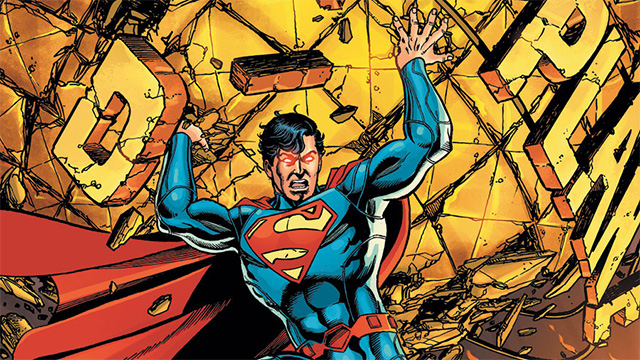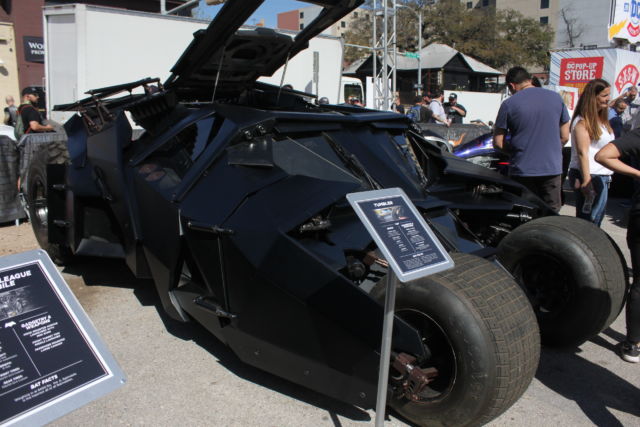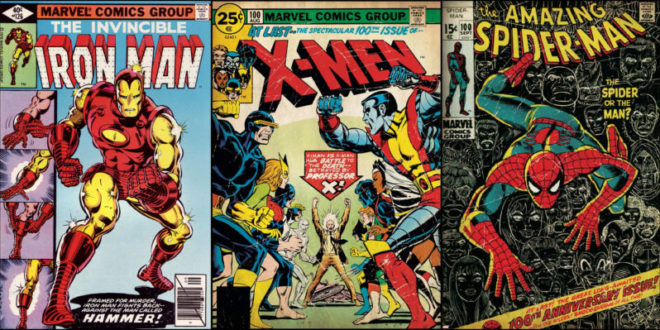Marvel Comics
From Wonder Woman to Watchmen, it’s not easy to envision what pop culture would be like today without the impact of superheroes. It’s also not easy to comprehend how any comic book about a flying alien, or a furious green monster, or a super-soldier who defeats a whole army by himself has anything to do with the worlds of technology and science. But as we all know, appearances can be deceiving.
Although the influence of superheroes on modern culture is undeniable, the influence of modern culture on many superheroes remains hazy to this day. Comic creators, perhaps often wanting to maintain a little mystique, have historically been hesitant to get explicit about their inspirations. But when thinking through 80-plus-years-and-counting of our favorite caped crusaders changing slightly with the times, their real world analogues become clearer and clearer.
Science and science fiction
One of comics’ most iconic heroes might also be the perfect example of this. Since his first appearance in Action Comics #1 in 1938, Superman has adapted to the times. The “Man of Steel” we saw in 2017’s Justice League didn’t just happen overnight, after all. Superman’s long term evolution is the result of many transformations and technological advancements throughout the decades.
Back in the beginning, his creators, Jerry Siegel and Joe Shuster, were huge fans of pulp science fiction and adventure magazines. As a result, some of the first clear influences seen in Superman come from such stories’, which often featured characters who possessed incredible abilities such as superhuman strength, telepathy, and clairvoyance. Some of these early influences include John Carter of Mars, a character from the sci-fi novels by Edgar Rice Burroughs; Hugo Danner, the main character in the novel Gladiator by Philip Wylie; actors Johnny Weissmuller, Douglas Fairbanks, Harold Lloyd, and Clark Gable; and several strongmen of the early twentieth century, whom Shuster idolized as a child.
Given its heavy influence on society at the time, religion also seemed to appear on the long list of things that informed the birth and evolution of the first mainstream superhero. Both Siegel and Shuster were Jewish, for instance, and this led many comic book fans (including Rabbi Simcha Weinstein and the British novelist Howard Jacobson) to the disputed conclusion that Superman’s main influence was Moses.
Siegel and Shuster never confirmed this claim, suggesting that the idea of Superman falling to Earth from the sky simply seemed like the coolest possible idea at the time. Instead, the only sources of inspiration for Superman’s initial powers that Siegel and Shuster openly admitted to were those of animal science and Newton’s law of universal gravitation. For instance, they accentuated that because Earth is a much smaller planet than Krypton, the lighter gravitational pull further enhanced Superman’s strength. They also borrowed feats from the animal kingdom, drawing a parallel between Superman’s amazing strength to that of an ant’s incredible ability to carry hundreds of times its own weight. And the duo compared a grasshopper’s ability to leap great distances with Superman’s ability to leap from one place to another.

Wait, he was just jumping at first?
DC Comics
Tall buildings in a single bound via transportation
Many newer fans of Superman might not know that he couldn’t always fly. He only started flying in the early 1940s—which, coincidentally, is shortly after Heinkel He 178, piloted by Erich Warsitz, became the world’s first aircraft to fly purely on turbojet power on August 27, 1939.
Some may think that this is a mere coincidence and that the developing technology behind high-speed flight had nothing to do with Superman’s newfound superpower. Some may even suggest that leaping simply wasn’t appropriate stylistically or even practical anymore, as the stories of Superman began to migrate into the worlds of animation and radio during the early 1940s. This is partly true. In the very first Fleischer Superman film, The Mad Scientist, Superman leaps rather than flies. But the result wasn’t very good, aesthetically speaking. In addition, the technical difficulties of having Superman “jump” around made editing a strenuous task for the films’ producers, as they didn’t have the proper editing equipment to do so back then.
A poor initial film aesthetic wasn’t the only reason Superman soon started flying, though. In fact, the dynamic progress in flight technology during the late 1930s and early ’40s and the rapid evolution of the turbojet gave Superman more than the ability to fly—it also gave him a new home. In his debut, Superman is a nameless baby appearing from an unnamed doomed planet. His father was a scientist who put his son in a spaceship to save him from the ensuing destruction. One day this spaceship lands on Earth, and this is the only description provided by DC Comics about Superman’s days on Krypton for pretty much the next seven years.
But in 1945’s More Fun Comics #101, which introduced us to Superboy, we learn more details about Superman’s technologically advanced planet and his birth name: Kal-El. We also learn that his previously undescribed spaceship didn’t just randomly land on Earth; Siegl and Shuster upgraded it to an experimental rocket that violently crashed to Earth before it was discovered in Smallville by Jonathan and Martha Kent. All this creative reconstruction of Superman’s background became possible because of the advancements in flight of that era, especially the period from 1936 to 1943. During that time, aviation engineers solved most technical difficulties and launched the age of the mass production of the Junkers Jumo 004, the world’s first production turbojet engine in operational use and the first successful axial compressor turbojet engine.
So as he jet-propelled forward, Superman didn’t only become the first superhero to go viral, he also became the archetype by which the industry would define itself. The golden age of comics, which basically launched with Superman in 1938, produced several iconic superheroes and villains in the years that followed. As they continued creating heroes to follow Superman, DC Comics continued to leverage their initial formula, drawing on some combination of animal science, religion, and mythology for the creation of superheroes like Wonder Woman, the Flash, and Aquaman; even for notorious villains such as Catwoman and the Penguin.
There was a bright exception to this rule, however—an exception going by the name of Batman. Unlike other superheroes of his time (and despite a very nature-y name), Batman was all about technology. And his “fathers,” artist Bob Kane and writer Bill Finger, made sure to heavily emphasize this by not giving him any superpowers at all.
For the unfamiliar: In contrast to Superman, Batman is all man and from here on Earth. He’s an ordinary guy with a lot of money and a very specific goal: He’s determined to avenge the terrible loss of his parents, who were murdered right in front of his innocent young eyes. In this battle for truth and justice, Batman relies solely on technology and his combat skills. Unlike Siegel and Shuster, Batman’s creators were pretty clear about their influences from the very first moment they imagined Batman.
Inspired by Leonardo da Vinci’s sketch of a bat-winged flying machine—a technological marvel of its day—Batman makes up for all the superpowers he doesn’t possess with a wide variety of interesting gadgets, including a utility belt, batarangs, and every high-tech device you can think of. His entire presence and activity in comic books (and subsequently on TV shows, in cartoons, and films), closely follows the advancements of twentieth-century technology. It wouldn’t be much of an exaggeration if someone were to claim that no other fictional character in history has promoted speedy cars, computers, cell phones, unrealistic-looking planes, and numerous other hi-tech devices, the way Batman does has his frequent use of bleeding-edge tech. Maybe unnamed Big Tech corporations in the headlines use this stuff for nefarious reasons, but Batman does all this in his quest to be a step ahead of his enemies and every dangerous criminal that threatens Gotham City.

Nathan Mattise
Military technology changes comics
When it comes to specific types of tech, Batman is also the first major superhero whose appearance has been so heavily inspired by military tech. This may be most obvious in how his costume has changed throughout the decades, from a cloth suit to an impermeable combat gear in films like Christopher Nolan’s Dark Knight trilogy.
Of course, fans of one Tony Stark’s willl probably disagree with that last Batman statement, which is the reason I made sure to say how Batman was the first and not the only, or the best, superhero created utilizing military technology. That honor belongs to Iron Man, and rightfully so, but Iron Man made his first appearance in Tales of Suspense #39 back in 1963, 24 years after Batman. This could mean that Stan Lee and Larry Lieber were inspired by Batman as much as the tech itself when they were creating the most hi-tech superhero in history.
Lee never admitted such a thing openly, and he instead cited a real-life personality, Howard Hughes, as Stark’s only influence. Nonetheless, like Batman, Iron Man comes from a wealthy family. They both mourned the loss of their parents at a young age and inherited a vast fortune. Bruce Wayne owns Wayne Enterprises, while Tony Stark is the absolute boss of Stark Industries. Bruce Wayne has Alfred, while Tony Stark has Jarvis. They both love armored suits and gadgetry and they both use science and technology against crime. Just like Batman, Iron Man lacks superpowers. The only difference is that the time Bruce Wayne spent learning martial arts, Tony Stark dedicated it to study engineering and physics. He entered MIT at age 15 and received his master’s before age 20. His extremely high IQ and highest-level education is his only “superpower.”
Even if the similarities with Batman were only coincidental, Lee and his colleagues could never deny the immense influence of modern technology on the development of Iron Man. (The famous metallic superhero was really kind of a “human satellite” not long after NASA launched Telstar, the first commercial satellite, in 1962.) An influence that became more obvious than ever before in 2013’s Iron Man 3. Here we see Stark controlling several robotic Iron Man suits that fight for him, but without him being inside the suit as we were used to seeing until that moment. In reality he pilots the first drone superhero in history by just using a joystick. Apparently, Marvel Comics and the film’s production team wanted to make it as obvious and blatant as it gets about their technological source of inspiration behind that scene: drones.
 Unmanned Aerial Vehicle The latest drone news
Unmanned Aerial Vehicle The latest drone news




